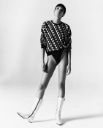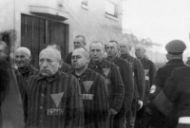From Oppression to Liberation
The package of the thong is decorated with black and white triangles. Triangles represent Rudi’s most basic aim: liberation from oppression.
On the one hand, Rudi regarded fashion as a liberating force to challenge conservative fashions. Viewed from the front, the thong is in the shape of an inverted triangle, but at the back the material is reduced to a minimum (fig. 8). This shape left very little cover for the bottom, which forced it to build upon the natural human form and fully reveal the shape of the human body.
Inverted triangles were originally symbols of persecution of gays and lesbians. As Jews were forced to wear yellow triangles, so did Nazi’s force people they labeled as gays and lesbians to wear inverted pink triangles (or ‘die Rosa-Winkel’, fig. 10). Rudi therefore also used these symbols to transform gay and lesbian people’s darkest history into a fashion statement.
Dynamic black and white triangles thus perfectly symbolize Gernreich’s principles in costume design (figs. 9-11). For Lily of France and for Gernreich, therefore, the thong’s packaging underscored these principles and ensured that the underlying message would not slip between the cracks.



](https://micrio.thingsthattalk.net/GEpfN/views/max/128x128.jpg)
